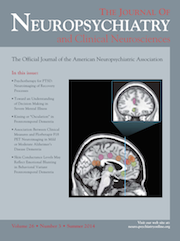To the Editor: Noonan syndrome (NS) is a genetically heterogeneous developmental disorder with an estimated incidence of 1:1000–2500 cases.
1 Core symptoms comprise typical facial features (hypertelorism, ptosis, and low-set ears), heart and skeletal anomalies along with variable cognitive/affective characteristics.
2 The mutable manifestation of NS-symptoms determines a diagnostic challenge, particularly when psychiatric and not somatic aspects prevail. This may explain why NS is hardly perceived in adult psychiatry. This report illustrates a case of an NS-patient, previously diagnosed with attention deficit hyperactivity disorder (ADHD) and autism spectrum disorder (ASD).
The 20-year-old man lost several jobs within the past year because of problems following verbal instructions. It took him too many attempts and time to execute these as required. Similar impairments had been observed at school where his classmates teased him for his awkward social behavior and appearance, particularly the open mouth because of malocclusion. His parents reported delayed childhood development.
Besides thrombopenia, laboratory tests, a recent cranial MRI, CSF-analysis, and EEG were without pathological findings. Neuropsychology revealed average intelligence and executive functions but problems with comprehension of metaphorical expressions. Concretistic and inflexible formal thinking was evident as well as constant verbalization of thoughts. These findings and the reported social difficulties had led to considering an ADHD or ASD in the past. Modafinil was prescribed under an explorative approach from a practitioner and led to a subjective improvement of fatigue, whereas deficiencies in social and cognitive expression remained.
Psychiatric examination confirmed the formal thought characteristics with no deficits in attentional or mnestic functions, nonaffective disorder, or hyperactivity. Occupational therapists reported inflexibility upon changing work environments and a meticulous, circumstantial task execution. In social interactions, the patient appeared self-centered but capable to attribute mental states to himself and others (theory of mind). Clinical examination identified facial dysmorphism (hypertelorism, bilateral ptosis, medial epicanthic folds, antimongoloid palpebral fissures, low-set ears, thick helix, low-posterior hairline, short neck, and dental malocclusion) besides a compact stature with a broad thorax. The cardiac examination revealed a negative T-wave, an incomplete right branch block, and regurgitation of the tricuspid and pulmonary valve. Considering the recent literature, these findings were suggestive for NS. As in about one-third of cases,
1 genetic testing of relevant gene mutations (
PTPN11, SOS1, KRAS, RAF1, MEK1) remained negative. According to a scoring system
2,3 calling for typical facial features (in this case: hypertelorism, ptosis, epicanthal folds, and low-set ears) and two minor signs (in this case: cardiac abnormalities and broad thorax), the diagnosis was established by clinical examination.
Psychological symptoms such as those observed in our patient (difficulties in social interaction, symptoms of inattention, cognitive inflexibility, and altered emotional perception) have been reported as integral aspects of NS,
2 although actual psychiatric diagnoses are rare other than mild mental retardation in some cases. Recent literature reports of higher levels of alexithymia and social discomfort, even though perception of emotions in others and mentalizing seem unimpaired,
4 similar to our patient.
Thus, this case should draw attention to NS with varying psychiatric complaints and should be considered in psychiatric patients with respective symptoms and suggestive facial and/or cardiac features.

